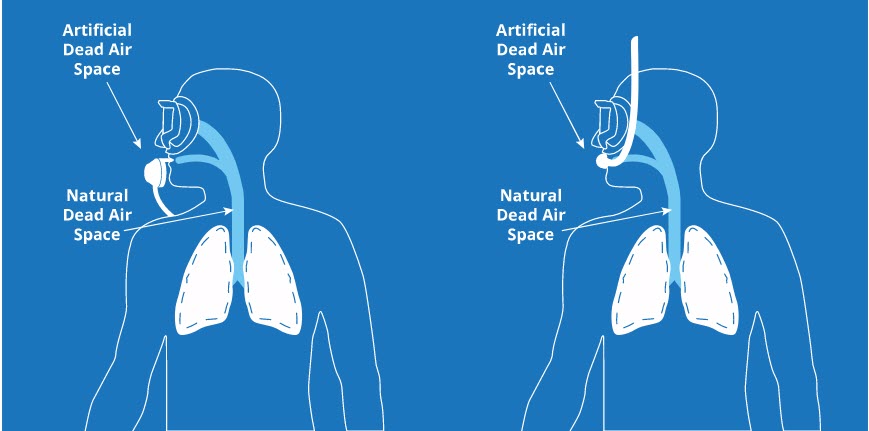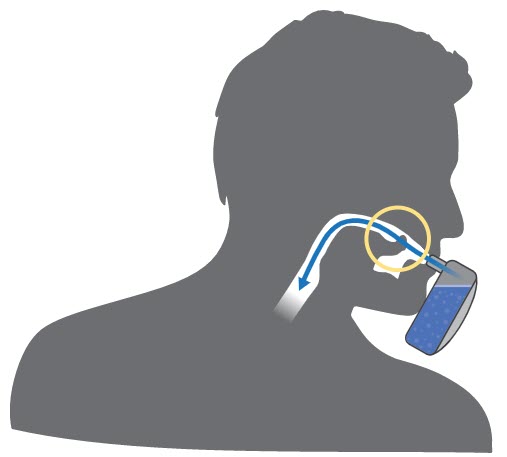Lesson 43
Learning Objectives
1. What is the most effective way to breathe while diving? Why is it important?
2. What is “airway control”? What are two techniques for it?
3. What are eight symptoms of overexertion while diving?
4. What causes overexertion while diving? How do I prevent it?
5. What should I do if I think I’m becoming overexerted at the surface and underwater?
Air Density and Dead Air Space
You’ll remember that when scuba diving, it is most effective to breathe slowly and deeply, because the air you breathe while underwater is denser than at the surface and requires more effort to breathe. And the denser the air and the faster you breathe, the more energy you use breathing.
Breathing slowly and deeply is also important for effective gas exchange. When you breathe, your body absorbs the oxygen it needs and releases waste carbon dioxide, but this occurs only in the lungs. Not all of the breathing passages take part in gas exchange. We call these air passages dead air space. The first air you inhale (“dead” air) with each breath is the air from your last exhalation, so it is higher in carbon dioxide.

Dive equipment adds dead air space. If you breathe shallowly and rapidly, you rebreathe a much greater proportion of dead air with each breath, and you have to use more energy to meet your body’s gas exchange needs. On the other hand, breathing slowly and deeply reduces the proportion of dead air in each breath.
You breathe slowly and deeply when you’re relaxed. Making a point of breathing slowly and deeply helps you stay relaxed, and it can help you calm down if you begin to feel anxious. Proper breathing also helps you stay clear-headed and make better decisions.
Airway Control
It is common to have some residual water in your regulator or snorkel, especially after clearing it. Airway control is the skill of breathing past this remaining water without drawing any into your throat. There are two basic techniques – after clearing your regulator or snorkel, assume it will have a little water left and use one or both.
The first technique is to inhale slowly. If you inhale slowly, water tends to stay in the mouthpiece while the air gurgles past into your mouth and lungs. It helps to look downward a bit.

The second technique is to touch your tongue to the roof of your mouth as you inhale. Your tongue will tend to block water as air flows around it. Again, looking a bit downward helps, and you can combine both methods.
Sometimes you get a few drops of water in the back of your throat, which create the urge to cough. Go ahead and cough – simply hold your regulator or snorkel in place as you do.
Overexertion
Overexertion while diving can be alarming, and may lead to panic and accidents. You can avoid and/or stop overexertion by recognizing its symptoms, causes and prevention, and by knowing what to do if you experience it. Overexertion symptoms include:
- Fatigue
- Labored breathing
- A feeling of suffocation or air starvation
- Weakness
- Anxiety
- Headache
- Muscle cramping
- A tendency to panic
Overexertion usually results from prolonged elevated effort, like fighting a current. It is caused by trying to breathe dense air rapidly, faster than equipment can deliver it. You prevent overexertion by breathing slowly, deeply and continuously. Avoid lengthy, strenuous exertion while diving. If your breathing rate begins to rise, stop and rest before it becomes labored.
If you experience overexertion, stop all activity, signal your buddy and rest. Further activity makes it worse. If you’re at the surface, inflate your BCD and/or drop your weights so you don’t have to fight to stay there. Signal the boat to pick you up, if appropriate. If you’re underwater, hold on to something or rest on the bottom where you won’t damage sensitive aquatic life.
After restoring normal breathing, resume activity at a lower pace, avoiding the effort that caused the problem. Remember that your goal is to always breathe slowly, deeply and continuously.

You’ll quickly notice that the most skilled divers have excellent buoyancy control. They seem to descend, ascend or hover midwater just by thinking about it. There’s more to it than that, but you’re witnessing Peak Performance Buoyancy.
Although you master the fundamentals of basic buoyancy control as part of earning your PADI Open Water Diver certification, the Peak Performance Buoyancy course fast-tracks you to this skill level. You learn to apply center-of-gravity and center-of-buoyancy concepts to refining weight placement and trim, as well as breathing and streamlining techniques. Because it helps raise your skills so quickly, it’s one of the first specialty diver courses new divers take after certification. See your instructor, PADI Dive Center or Resort, or visit the Peak Performance Buoyancy page at padi.com.
Quick quiz
Module Two

I'll take you diving!
Copyright © Larry Wedgewood Scuba Instruction All Rights Reserved

